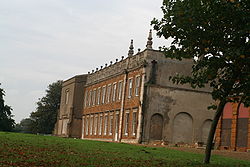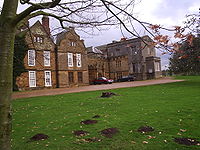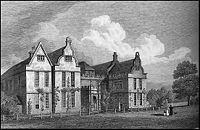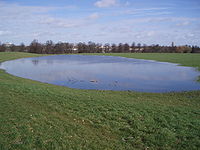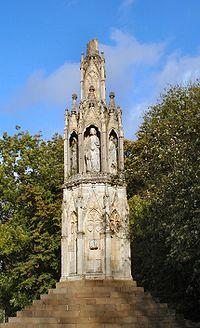- Delapré Abbey
-
Delapré Abbey (The Abbey of the meadow), or more properly, the Convent of St Mary De La Pré, was founded as a Cluniac nunnery about the year 1145, situated in the meadows of the River Nene to the south of Northampton .
The convent was founded by Simon de Senlis in the reign of King Stephen; it held a Royal Charter from Edward III. At its founding, the convent was endowed with land at Hardingstone and held the churches at Earls Barton, Great Doddington and Fotheringay (confirmed by the Scottish Kings Malcolm and William). Edward III increased their holdings with the churches of Wollaston and Filgrave and also granted them the advowson of the church at Fyfield, Hampshire. Edward III is recorded as giving "ten beams" towards the repair of the church in 1232, and another five oaks for work on the Refectory in 1258.
It was one of only two Cluniac nunneries built in England (the other being at Arthington in Yorkshire); the Cluniac order was one of reformed Benedictine rule; it was led directly by the great abbey at Cluny in Burgundy. Typically a dozen to twenty nuns resided at the abbey at any one time. Traditionally the Guild of Weavers at Northampton made an annual procession to the Abbey church each Easter Monday where, according to the ordinances of the Guild in 1431, they would offer up "...tapers before the ymages of the Trynitie and our Lady."
Nearby was the Cluniac Abbey of St Andrews (now the site of St Andrew's Hospital), which was founded by Simon de Senlis, Earl of Northampton, the father of the founder of Delapré.
After much later use as a private residence and in war service, the house was converted for use as the Northamptonshire County Records Office and the County Record Society. Currently the house is empty and a fierce debate continues locally over its future use. The building is Grade II* listed.
Some longtime residents claim there were accounts of an underground passage linking the nunnery to a friary based in the centre of Northampton, by way of Bridge Street. The Abbey is reputed to be haunted by a "blue or grey Lady", a nun, said to have been seen frequently on the main staircase (the habits of Cluniac nuns were blue).[citation needed]
A short history of the Abbey
- 1145 - Delapré Abbey was built by Simon, the son of Simon de Senlis the 2nd Earl of Northampton.
- 1290 - The death of Queen Eleanor, Queen of England. On 28 November 1290, Eleanor of Castile the wife of Edward I died at Harby, Nottinghamshire. Her body was embalmed at Lincoln, and on 4 December a procession began to Westminster Abbey accompanied by the King. The procession travelled through Northampton and to the convent at Delapré for the night. The King stayed at Northampton Castle. The following day the procession left Delapré and at the top of the hill, the ground was consecrated. On this spot, one of the Eleanor Crosses was erected.
- 1460 - The Battle of Northampton between the Yorkists and Lancastrians took place at Delapré.
- 1538 - Under the dissolution of the English Reformation, Henry VIII forced the Abbey to surrender to the Crown.
- 1543 - The Crown let the Delapré estate to a tenant.
- 1550 - The Crown sold the Delapré estate to the Tate family.
- 1756 - Sir Charles Hardy, Governor of New York, husband of Mary Tate, sold the estate to Edward Bouverie for £22,000.
- 1905 - The Bouverie family let the Abbey estate to John Cooper, a Northampton boot and shoe manufacturer.
- 1914 - Miss Mary Bouverie moved back to the Abbey.
- 1940 - The War Office took over the Abbey. Miss Bouverie moved to Duston and later returned to a room over the stables in 1942; she died on 20/1/1943.
- 1946 - The Northampton Corporation purchased the estate for £56,000.
- 1948 - The War Office gave up its use of the Abbey house after the end of World War II.
- 2004 - Seven people began living in the south & west wings as live-in security. As of 2010 there were still seven people, two from the original group.
- 2005 - The Northampton Borough Council announced plans to form a new Delapré Abbey Trust.
The Abbesses of the Convent of St Mary De La Pré

- Azelina 1145
- Missing
- Cecilia de Daventry - elected 1220
- Agatha - died 1274
- Emma Malore - elected 1274, died 1282
- Margery de Wolaston - elected 1282, died 1296-7 - The Abbess at the time of the death of Queen Eleanor
- Margery de Broke - elected 1297, resigned 1319
- Agnes de Poveley - elected 1319, died 1327
- Margaret de Grey - elected 1327-8, died 1333-4
- Isabel de Cotesbrok - elected 1333-4, annulled by the bishop
- Katherine Knyvet - appointed 1333-4, died 1349 of the plague
- Isabel de Thorp - appointed 1349, resigned 1366
- Joan Mallore - elected 1366, died 1394
- Margery Dayrell - elected 1394
- Gonora Downghton - died 1481 - The Abbess at the time of the Battle of Northampton
- Joan Doghty - elected 1481
- Joan Chese - elected 1492
- Clementina Stock - elected 1504-5, surrendered 1538
An impression of the great oval seal of the Abbey is held in the Public Records Office. It represents the coronation of the Blessed Virgin under a carved canopy.
The Cluniac Prayer
"O God, by whose grace thy servants the Holy Abbots of Cluny, enkindled with the fire of thy love, became burning and shining lights in thy Church: Grant that we also may be aflame with the spirit of love and discipline, and may ever walk before thee as children of light; through Jesus Christ our Lord, who with thee, in the unity of the Holy Spirit, liveth and reigneth, one God, now and for ever."
The second Battle of Northampton (1460)
After the Battle of Northampton, which took in the Abbey grounds to the north of the Abbey and to the south of the River Nene, King Henry VI was captured and spent the night of the 10 July 1460 at the Abbey as a prisoner. The nuns tended the wounds of those injured at the battle. Many of the battle-dead are buried in the nuns' graveyard (now the walled garden).
After the dissolution
In 1542 the Tate family purchased the Delapré Estate from the Crown; they started work on the gardens. Zouch Tateis recorded as having laid out a typical Elizabethan-style garden. This is thought to have been where the enclosed formal garden can now be found.
The Tates lived at Delapré until 1764, when they sold the estate to the Bouverie family. The majority of the present buildings date from this time. The design of the grounds became influenced by the style of Capability Brown. The Bouverie family changed the garden to one featuring fruit and vegetables, with orchards planted elsewhere. This was similar to the earlier fruit garden of the original nunnery. Researchers believe the present walled garden is located on the site of the nuns' burial ground, as evidence of graves was discovered during the garden's construction.
During the 19th century, other typical Victorian features were added, such as the rock and water gardens, and garden conservatories for peaches and grapes. The buildings for growing fruit still remain; a ha-ha was also constructed.
The present buildings
- What remains today consists of four ranges based around an almost square courtyard; this is probably all that remains of the earlier cloisters, with the passage around the north, west and east sides being the former cloister walks.
- The thicker walls found in the northern part of the building are probably part of the walls of the church of the nunnery. Almost nothing of the medieval buildings remain; two small recesses found in the cloister walk may have been used for keeping candles at night.
- What is seen today is the result of work that started with the passing of the house to the Tate family after the dissolution.
- The stables at the northern end of the property date from around 1750-65. They were renovated in 1971 by John Goff, then County Architect.
The future of the Abbey
A volunteer group, "The Friends of Delapré Abbey" runs a tea room on the premises. This helps attract many new and repeat visitors to the building and its grounds. The organisation was granted charitable status in June 2006. In recent times certain sections of the charity have been actively reluctant to change and develop the organisation in line with the local Council's plans for restoration. This has held up the plans until a recent committee change re-established the Council's confidence in the charity's ability to act in a transparent professional manner.
The Northampton Borough Council founded "The Delapré Abbey Preservation Trust", intended to take forward the ownership of and responsibility for the Abbey. The Council intended that the Trust will work to secure the future of the buildings by finding sources of income streams to allow renovation of the buildings.
The grounds today
There are about 500 acres (2.0 km2) of parkland and 8 acres (32,000 m2) of more formal gardens. The more ornamental features include:
- Delapré Abbey
- A walled garden
- Rock and water gardens
- A ha-ha
- Tree sculptures
- Delapré Woods
- A lake
Part of the estate has been developed as the public Delapré Golf Course.
The Northampton Borough Council (NBC) added bunding to the London Road side of the grounds to prevent unauthorised vehicular access to the grounds. In the wet spring of 2007, this caused a flood lake to appear, which was condemned as dangerous to the public. In November 2006, NBC's planning committee approved an application to remove the bunding but successive administrations have to date not provided funds to perform the work - despite public concerns over the flooding. The Homes & Communities Agency has since indicated an interest in using the bund material on a nearby housing development.
The formal garden
In 1977 and 1978 three sculptures were installed in the walled garden:
- "The Lady with Kittens" and "The Lovers", the work of Walter Ritchie, were donated to Northampton after being displayed at an exhibition of brickwork sculptures at The Building Centre, London. The large brick panels depict episodes in the life of the mythical lady, Sarah Wellington-Gore.
- "Woman and the Fish" is a listed sculpture by Frank Dobson, one of UK's most respected sculptors. This was given to Northampton after the Festival of Britain in 1951. It previously stood in the Memorial Gardens in the town centre, where it had been vandalised. It was repaired and transferred to its current location after an appeal for funds to meet the high costs of restoration.
The Eleanor Cross
One of only three remaining Eleanor Crosses is located at the Hardingstone end of the Delapré Abbey estate. The body of Queen Eleanor, wife of Edward I, rested at the Abbey on its journey from Lincoln to London. The king erected the crosses to mark the passage. The cross was begun in 1291 by John of Battle; he worked with William of Ireland to carve the statues.
External sources
- "Delapre Abbey", Northampton Borough Council
References
Further reading
- The Buildings of England - Northamptonshire. N Pevsner (Second edition). ISBN 0300096321
- British History Online - House of Cluniac Nuns - The Abbey of Delapré
- Colin Spears, Delapré Abbey, ISBN 978-0-9553692-0-9
Categories:- Grade II* listed buildings in Northamptonshire
- Monasteries in Northamptonshire
- Churches in Northampton
- Benedictine monasteries in England
- History of Catholic monasticism
- Cluniac nunneries
- 1145 establishments
- Religious organizations established in the 1140s
- Christian monasteries established in the 12th century
- Reportedly haunted locations in England
Wikimedia Foundation. 2010.

